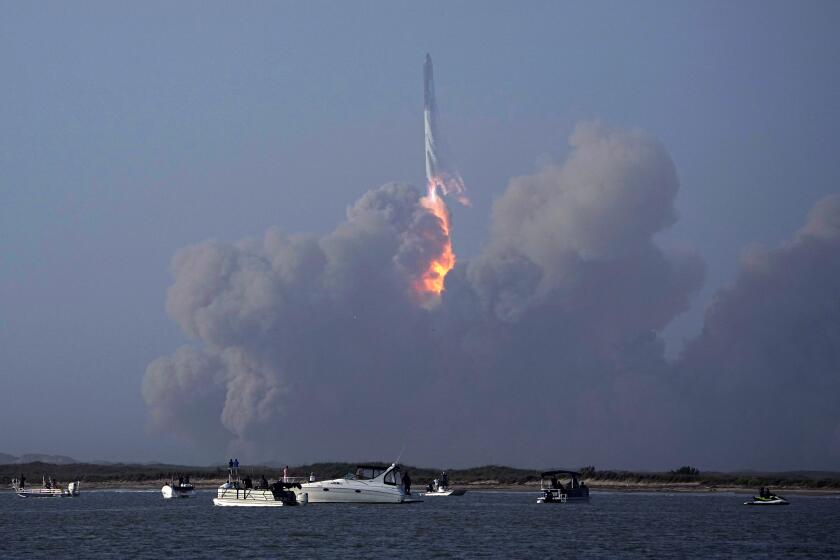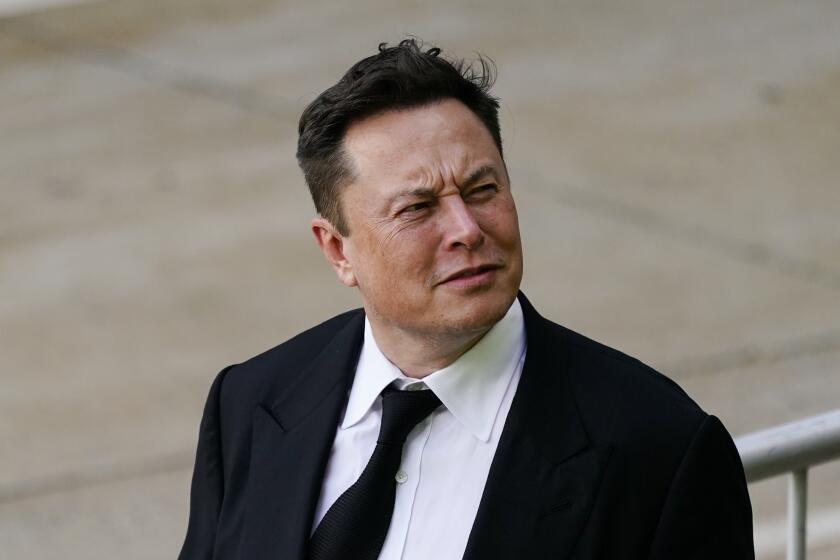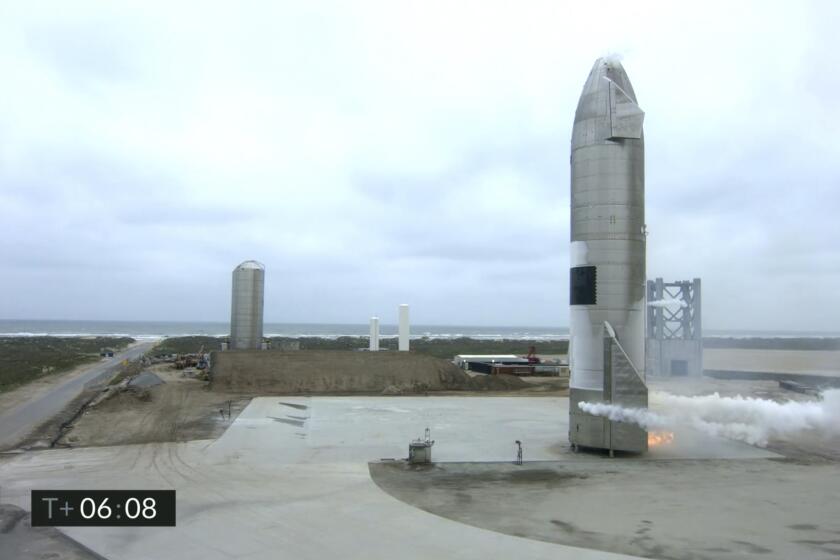Opinion: Hate Elon Musk? That’s OK, but root for SpaceX’s Starship rocket

- Share via
Elon Musk is the most morally dubious rocket pioneer since Wernher von Braun. And the most successful. With each, we can critique faults and celebrate achievements.
Von Braun, who supervised the V-2 weapon program for the Third Reich and once calculated the number of slave laborers needed for more efficient production of the system, went on to supervise America’s Saturn V moon rocket. The latter was laudable. The former probably would have led to Von Braun’s arrest by the Allies had we not needed his expertise.
By comparison, the oft-brilliant Musk seems merely arrested. He’s widely perceived as a reactionary, thin-skinned, insensitive, sleep-deprived bully who promotes ludicrous opinions on everything from COVID to, well, pick your topic. So last week’s “RUD” — or “rapid unscheduled disassembly” — of Musk’s Starship rocket delighted his critics. (Of course, Starship isn’t his only RUD. There’s Twitter, after all.)
This was the first launch attempt of the company’s massive Starship moon rocket, which is crucial for the future of both SpaceX and U.S. plans for human space exploration.
And yet, as founder and head of SpaceX, Musk has inspired a generation of aerospace engineers to work very hard for him because he shares their belief in the aspirational and practical value of space exploration and settlement. So do I.
Pioneering rocket reusability with its Falcon 9 rocket, SpaceX has utterly transformed the space launch industry, cutting costs and materials waste. To achieve reusability, SpaceX, ironically, literally burns through a lot of rockets as it perfects designs. This is a throwback to the early days of the Space Age. Build ’em fast, launch and learn. If they blow up — wash, rinse, repeat.
NASA now could never get away with that approach. It has to perfect its systems before the countdown. That’s partly why its new Space Launch System, built by Boeing and Northrup Grumman, was oft delayed and over budget. But unlike Starship, SLS flew like a dream on its maiden voyage last year.
Starship, not so much. The massive, nearly 400-foot, retro-looking two-part craft cleared the launch pad (which will need repair and redesign) and experienced “max q,” the realm of heaviest stress on the ship. But four minutes and 24 miles into the flight, Starship malfunctioned and automatically self-destructed. All 33 Raptor engines did not ignite, which is worrisome. Engineers have a lot of data to pore over from a “successful failure.”
A group of Tesla investors has accused the company of mismanagement and seeks a meeting with its board to discuss the performance of CEO Elon Musk.
As Casey Dreier, chief policy advocate for the Pasadena-based Planetary Society, told me, “The vast scale of Starship is hard to express in words, but with massive scale comes increased complexity, presenting a whole host of novel problems to solve by SpaceX’s engineers. Something as wildly ambitious as Starship has not just never been done before …. The fact that they got as far as they did on the very first flight test is remarkable.”
The next time Starship launches, let’s hope it will be a successful success. If it isn’t, we may not be able to land the first woman and first person of color on the moon in 2025. Starship is meant to be the landing vehicle for NASA’s Artemis 3 lunar South Pole mission. NASA will send four astronauts in an Orion capsule using its Space Launch System, while Starship launches to Earth orbit, refuels, flies to the moon and awaits two of the astronauts who will transfer to it for the landing.
Before that mission, SpaceX probably needs a successful suborbital launch of Starship, a successful orbital flight, development of the refueling procedure in Earth orbit and a test landing on the moon. That’s a lot to accomplish in the next two years.
“I don’t know if it will be ready by 2025,” Dreier admits. “But what makes this novel, and what prevents me from completely writing off this timeline, is that SpaceX has simultaneously spun up a production line of Starship rockets. This enables rapid iteration, frequent tests and, most importantly, allows for failure early on ... and hopefully we’ll see them improve with each attempt.”
SpaceX has finally launched and successfully landed its futuristic Starship
Musk is free to be an unlikable, visionary weirdo. NASA, the agency we all “own,” will always be more popular than a spiky billionaire.
Not that we shouldn’t call out Musk for untoward speech and behavior. If his companies break the law, they should be held to account. SpaceX gets taxpayer money, after all. Yet we can — should — also hope for SpaceX and its multiplanetary ambitions to succeed.
It’s notable that scientists are salivating at the capacity of Starship. It could launch ambitious science missions and Earth-monitoring satellites because one Starship is designed to loft at least 100 tons to low-Earth orbit. That’s 20% of the entire annual payload now sent into space in multiple missions.
Most observers think Starship will prove out, be built faster and launch more frequently than, say SLS, which is also a “heavy lifter” system. That’s good for space exploration and for NASA. I want Starship to succeed because I believe it ultimately helps humanity nurture a vibrant, just future. On the other hand, I wouldn’t mind it if Elon Musk’s Twitter were to fail — for the same reason.
Christopher Cokinos’ book “Still as Bright: A Backyard Journey Through the Natural and Human History of the Moon” is forthcoming in 2024.
More to Read
A cure for the common opinion
Get thought-provoking perspectives with our weekly newsletter.
You may occasionally receive promotional content from the Los Angeles Times.













